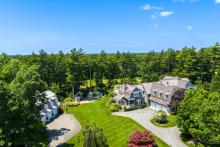Water pollution levels stem; then rise
The 2016 drought resulted in a temporary decrease of nitrogen runoff into Buzzards Bay, and thus, a healthier bay. But conservation experts say this spring’s heavy rainfall is reversing those gains -- and the result can be seen especially in the tri-town’s inner coves.
The nonprofit Buzzards Bay Coalition, which works to monitor the health of the bay, recently released a report detailing decreased nitrogen levels during 2016, and warned that an uptick in nitrogen levels would occur this year.
The coalition grades locations throughout Buzzards Bay from “poor” to “good” on a scale of 0-100. A “poor” score (0-35) indicates an excess of nitrogen pollution and a non-viable ecosystem. The highest score, “good,” (65-100) indicates little to no nitrogen pollution.
In Marion and Mattapoisett, much of the outer shoreline is ranked as "good.” However the inner areas, such as Inner Aucoot Cove, Inner Sippican Harbor, Planting Island Cove and Inner Wings Cove in Marion, as well as Brandt Island Cove and Inner Mattapoisett Harbor are ranked "fair," indicating damaging or increasing levels of nitrogen pollution.
The worst ranked in the tri-town in 2016 were Hammett Cove in Marion and the mouth of the Mattapoisett River. Both are considered to be "poor.”
The problem this year is that all the nitrogen that ended up in the ground last year stayed there, as there was little to no rain to flush it out. When the drought broke and the rainy spring followed, the potentially two seasons’ worth of nitrogen began flushing out of the ground and into the water, according to the Buzzards Bay Coalition.
“All of that nitrogen didn’t go away,” Coalition Science Director Rachel Jakuba noted. “We’re just getting it [into the water] later.”
The problem with nitrogen, which is naturally present in human waste and found in fertilizers, is that it makes things grow. Nitrogen from septic systems, wastewater plants, and fertilizer regularly ends up in the ground, and rain washes it into the waterways.
"Excess nitrogen causes 'over-fertilization' of the water," Jakuba explained. "More algae grows in the water, sucking up oxygen for the other plants and animals."
That can lead to the death of shellfish and other marine life, including eelgrass, which is a keystone in the ecosystem. Juvenile fish hide in the eelgrass, and scallops grow on the blades.
The main sources of nitrogen pollution in the tri-town are Marion's wastewater treatment plant and private septic systems.
The treatment plant has long been a source of concern in Marion. New U.S. Environmental Protection Agency regulations require that the treatment plant be upgraded, and that three sewage lagoons be lined to prevent wastewater from leaching into the surrounding soil. A study conducted by the Buzzards Bay Coalition in 2011 noted that the estimated leakage of nitrogen from the lagoons was around 33,400 pounds per year.
The coalition further noted that 50 percent of the leaked nitrogen leached into Aucoot Cove; 30 percent leached into Sippican Harbor and 20 percent into the Benson Brook area.
Marion and Mattapoisett have attempted to stem the other major source of nitrogen pollution -- private septic wells.
At a Marion Selectmen meeting held earlier this year, Town Administrator Paul Dawson brought up the idea of tying Aucoot Cove's sewer into the town sewer system -- however, the town sewer system is already strained.
Roughly five years ago, Mattapoisett installed a stormwater discharge system on Water Street that filters out contaminants such as nitrogen. Additionally, sewer extensions were installed four years ago on Mattapoisett Neck Road. Around 200 homes were tied in.
Most waterways in Mattapoisett have responded well, but the mouth of the Mattapoisett River is still considered “poor,” which indicates problems further up the river, according to the Coalition. Those problems include fertilizer runoff from lawns, cranberry bogs and golf courses, as well as runoff from Route 6 and I-195.
A continued leach of nitrogen in the soil could lead to much less diversity in aquatic plants and animals throughout the bay, and within tri-town waters.
“Only a few plants and animals can handle the lack of oxygen,” Jakuba explained. "There will only be a select few species that can survive in that water.”
For more information about nitrogen pollution and the health of Buzzards Bay, visit www.savebuzzardsbay.org.
















